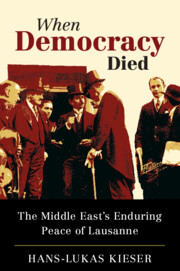Book contents
- When Democracy Died
- When Democracy Died
- Copyright page
- Contents
- Figures
- Maps
- Acknowledgments
- Introduction
- Part I A Century’s Pivotal “Peace”
- Part II Against the Paris-Geneva Peace: Bolsheviks, Turkists, Islamists
- Part III A Protracted Conference: Redefining Turkey, Western Realpolitik
- Part IV Post-Lausanne Turkey: Most Favored Dictatorship?
- In Lieu of a Conclusion
- Annexes
- Select Chronology
- Select Bibliography
- Index
Introduction
The Historic Near East Peace of Lausanne
Published online by Cambridge University Press: 20 April 2023
- When Democracy Died
- When Democracy Died
- Copyright page
- Contents
- Figures
- Maps
- Acknowledgments
- Introduction
- Part I A Century’s Pivotal “Peace”
- Part II Against the Paris-Geneva Peace: Bolsheviks, Turkists, Islamists
- Part III A Protracted Conference: Redefining Turkey, Western Realpolitik
- Part IV Post-Lausanne Turkey: Most Favored Dictatorship?
- In Lieu of a Conclusion
- Annexes
- Select Chronology
- Select Bibliography
- Index
Summary
The Middle East is a global hotspot. Peace in the Middle East is among the most significant challenges of the twenty-first century and the topic of this book. Of particular concern is the former Ottoman imperial core region that had remained part of the sultanate-caliphate until the 1910s: Anatolia (today’s Turkey), Iraq, and “Greater Syria,” including Lebanon, Palestine, and Jordan. The negotiators at the Near East Peace Conference in Lausanne in Switzerland, 1922–3, rightly insisted that they faced the challenge of “world peace,” that is, of working for the world’s most precious common good. This Conference and its outcome, the Treaty of Lausanne, mark the end of a world war that proved particularly long and devastating in the Middle East.
- Type
- Chapter
- Information
- When Democracy DiedThe Middle East's Enduring Peace of Lausanne, pp. 1 - 19Publisher: Cambridge University PressPrint publication year: 2023

